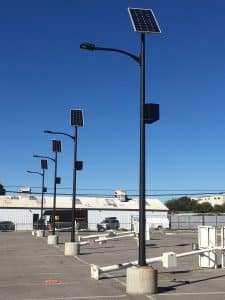What in the World is a Light Fixture (and What Are the Best Ones for Solar Lights)?Posted by Stephen Shickadance in The Basics.
Here at Greenshine, we toss around lighting terminology all day--lumens, wattage, temperature coefficients, mono- and poly-crystalline--the jargon can get particularly heavy. We thought we'd educate the masses through defining what a fixture is, how fixture technology has advanced in the past few years, and how that matters when it comes to solar LED lighting. Check out this 5-minute read on the greenest lighting technology available. Light Fixture Fixin'sA fixture is defined as an electrical device that contains an electric lamp that provides illumination. It's definitely a broad term, and yes, you can even find them in your home and outdoors on light poles. They're considered the "main deal" when it comes to solar LED lights. Some are pretty basic, some can get very ornate, and others are purely functional without any decorative flare. Not one fixture fits all situations though, and so we've dived into some of the best solar outdoor light fixtures for streets, public areas, parks, and other purposes. Just so you're aware, this isn't an exhaustive list of fixtures, only the best for exterior solar lights found at Greenshine. Type IIThe first fixture that Greenshine offers, Type II fixtures are slightly wider than their predecessors (aptly named Type I) so that the spread of LED light is a little broader. Whereas Type I has a very narrow band, Type II is better for sidewalks, park paths, and wider areas that see a lot of foot traffic. It's a highly common light fixture and one of the most popular for pedestrian paths located by the roadside or in public parks. Check out an example of how our Lita line improved a pathway located in a park for the enjoyment of nearby residents. Type IIIType III lighting systems are wider solar outdoor light fixtures meant for parking lots, wider areas of foot traffic, street lighting, and other areas that require broader lighting beyond pathways. This fixture works ideally with a lateral width of 40 degrees. These are currently the most popular for Greenshine and used on a wide variety of solar LED light installations across the US. Type VType V utilizes a circular layout so that every light gets maximum exposure without specific direction. It's suggested that these kind of solar outdoor light fixtures are used in sprawling parking lots, high-traffic streets, and anywhere where there needs to be wide, untargeted coverage. Typically these are found in larger parking lots, construction yards, and places where coverage is key. All of these LED fixture Types work within Greenshine's pole-mounted lighting solutions including the Supera, Brighta, Lita, and other solar outdoor light fixtures we manufacture. How Light Fixtures Have ImprovedWith every product iteration, we've improved efficiency and price per watt. You see, the light fixture isn't just about where the light is held. The light fixture is highly engineered by experts to maximize output, minimize potential harm to the fixture (heat can significantly reduce efficiency), and increase functionality. The newest light fixtures that Greenshine offers are 15% more efficient per watt than previous models, resulting in a brighter area of light that uses less energy drawn by the solar panel and stored in the battery. LED lights have seen a price drop of 150$ per kilolumen in the span of eight years. In 2030, who knows how efficient and inexpensive LEDs will be? Plus, since we're talking solar outdoor light fixtures, they don't need centralized power connectivity so you can save on trenching and wiring, which are usually very expensive tasks--some lights require approximately $4,000 per light just for connectivity. That's no pocket change. HeatVast improvements in heat dispersion have boosted LED longevity significantly. The junction temperature is the primary culprit behind the eventual deterioration of an LED light, which is raised by what's called the ambient temperature and the drive current. Junction temperature is often managed on the newest light fixtures by high-quality heat sinks or cooling fans to dissipate heat, prolonging the life of the light (an average LED light will last about 11 years with 12 hours of use a day). Heat happens to be the #1 LED killer, but modern enhancements have drawn away high temperatures so that LEDs last even longer than they used to. Smart ControlsOne of the newer functionalities for solar outdoor light fixtures is that smart controls can be added to the mix. Lighting isn't just a matter of being "on," it's a matter of giving complete control of the lights to improve longevity and functionality. A solar light can be configured to turn on at the start of dusk and slowly ramp up brightness to "full" brightness once the sun's light isn't adequate for an area. Each light can be configured to be "on" at a certain percentage during a specific time of day so that the target area gets as much light as it needs--reducing overall fixture and battery usage, thus increasing longevity. We're sure solar outdoor light fixtures left on at full brightness all day won't last as long as lights that are turned on only when needed. Plus, each light can be connected to motion-control cameras to blink on as soon as motion is detected. Smart controls and added functionality like this bring security where it's needed most--we've seen vast improvements in safety for rural areas since we've installed some of our systems in remote areas where grid power isn't available. We hope this brief introduction to exterior solar light fixtures is great for anyone curious about how they operate and how they've improved over time. Perhaps by 2030 we'll see even higher efficiency ratings and lower prices for LEDs. For now, contact us to learn more about what we can do for your lighting needs through the power of solar LED lights.
The Basics
|
ArchivesNo Archives Categories
Want More Info? |
LATEST NEWS & ARTICLES
